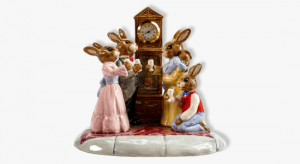We have been successfully selling Royal Doulton pottery here at Potteries Auctions for over 25 years. As we’re based in The Potteries, it has been an integral part of every one of our sales since the beginning, and we have a huge database of clients who are interested in buying and selling ware from this most famous of manufacturers.
Potteries Auctions can identify and provide valuations on a wide range of Royal Doulton pieces.
Top Selling Royal Doulton Items at Auction

George Tinworth for Doulton Lambeth, a comical mouse group “Guy Fawkes”
£5,000

George Tinworth for Doulton Lambeth, ‘Crossing the Channel’
£6,800

Royal Doulton prototype figure Mrs Bunnykins. With travel cases in yellow dress
£8,600

Rare Royal Doulton Flambe/Sung model of St George on horseback
£7,500

Royal Doulton prototype Bunnykins tableau Celebration Time
£35,500
Got an interesting item?
Speak to one of our experts to find out the value of your pottery, antiques, jewellery, & collectables
Book a valuationWhether you are looking to buy or sell Royal Doulton collectables, the team of experts at Potteries Auctions can help you find the piece you are looking for, or value your items for sale. Request a call back if you are looking for a valuation and are seeking to sell some Royal Doulton collector pieces at auction.
Royal Doulton Pottery Facts
- Royal Doulton has a long history with the Staffordshire Potteries region, with a factory in Burslem since the 19th-century, but manufacturing was first based out of Lambeth in London, when the company was initially founded as Jones, Watts and Doulton.
- A tiny stamp was printed on all products manufactured between the years of 1928 and 1954. If you add this number to 1927, you will get the year the piece was manufactured.
- In the 1840s, the company was a very successful manufacturer of sewage pipes!

The History of Royal Doulton
The Royal Doulton story began in 1815, when John Doulton invested his life savings of £100 in a small riverside pottery in Lambeth, South London, together with Martha Jones and John Watts.
This pottery, one of many in the area, specialised in manufacturing a range of utilitarian salt-glazed stoneware. In 1835, Henry Doulton joined the firm and it flourished due to Henry’s role in the ‘sanitary revolution’ – pioneering the general use of stoneware drain pipes and water filters to improve living conditions.
Henry Doulton was an innovator of his day and he came up with several ingenious ways of engineering and manufacturing the pipes and other stoneware items that made Doulton & Watts world-class experts in the field. Their wares were exhibited at the Great Exhibition held in London’s Hyde Park in 1851.
In 1860, the business diversified further after Henry offered work to designers and artists from the Lambeth School of Art. The first to be employed was George Tinworth, followed by artists such as the Barlow family (Florence, Hannah and Arthur), Frank Butler, Mark Marshall and Eliza Simmance. This resulted in pieces that were the opposite of the industrial pieces, as they were items that were delicately modelled, brightly coloured, exquisitely decorated and won the hearts of collectors all over the world.
In 1877, Doulton purchased the small factory of Pinder, Bourne & Co, at Nile Street in Burslem, Staffordshire, which placed Doulton in the region known as ‘The Potteries.’

Queen Victoria was a notable fan and Henry Doulton was knighted by the queen in 1887 for his services to ceramics and the advancement of ceramic art. In 1901, 4 years after Henry’s death, King Edward VII granted a Royal Warrant and the right to use ‘Royal’ in the name. The company was then known as Royal Doulton.
In 1913, CJ Noke launched his HN series just in time for a Royal visit. Queen Mary singled out a charming figurine by Charles Vyse, and exclaimed ‘Isn’t he a darling!’ and he was immediately promoted to HN1 and renamed.
Royal Doulton captured the Queen’s Awards for Industry, Technological Innovation and Outstanding Export Performance for its contribution to china manufacturing in 1966.
A very large, beautiful ceramic frieze depicting Pottery Through the Ages was designed and modelled by the sculptor Gilbert Bayes for the facade of Doulton House in Lambeth. Manufacture of ceramics ceased at Lambeth in 1956, and in 1968 Royal Doulton moved their headquarters to Stoke-on-Trent. Doulton house was sold and remained empty until 1978, when a decision was made to demolish the building. Volunteers from Ironbridge Gorge Museum rescued the frieze which was taken to Ironbridge for storage, and was installed in the Victoria & Albert Museum in 1988.
Get In Touch
Potteries Auctions can collect items for auction from anywhere in the UK, and we can also handle large collections from all over the world, so just get in touch with us to discuss. We pride ourselves in our packing and shipping service to get goods out to purchasers, making it a perfect solution for buyers who can’t attend auctions in person.
Sign up for our newsletter
If you would like to receive advance notification of upcoming auctions and sale notifications, then please subscribe to either our text alerts or email newsletter via the buttons below.
